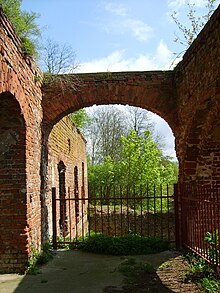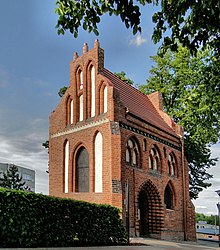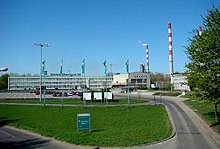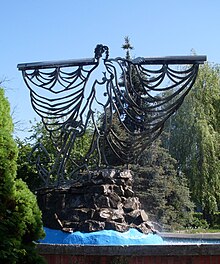Police (West Pomeranian Voivodeship)
| Policy | ||
|---|---|---|

|
|
|
| Basic data | ||
| State : | Poland | |
| Voivodeship : | West Pomerania | |
| Powiat : | Policy | |
| Gmina : | Policy | |
| Area : | 36.84 km² | |
| Geographic location : | 53 ° 33 ' N , 14 ° 34' E | |
| Height : | 6 m npm | |
| Residents : | 41,735 (June 30, 2015) | |
| Postal code : | 72-010 | |
| Telephone code : | (+48) 91 | |
| License plate : | ZPL | |
| Economy and Transport | ||
| Street : | DW114 Nowe Warpno ↔ Tanowo | |
| Rail route : | PKP line 406: Szczecin – Trzebież Szczeciński railway line | |
| PKP line 431: Police – Police Chemia railway line | ||
| Next international airport : | Szczecin-Gollnow Airport | |
| Administration (as of 2008) | ||
| Mayor : | Wladyslaw Diakun | |
| Address: | ul.Batorego 3 72-010 Police |
|
| Website : | www.police.pl | |



Police [ pɔlʲiʦɛ ] (German Pölitz ) is a city and seat of Powiat Policki (District Police) and the same urban and rural community police in the Polish West Pomeranian Voivodeship . The medium-sized town, which houses one of the largest chemical plants in Poland , has around 41,500 inhabitants.
Geographical location
Police is located in eastern Western Pomerania on the left side of the Oder and on the eastern border of the Ueckermünder Heide , about 15 km north of Stettin .
City structure
- Stare Miasto ( old town )
- Nowe Miasto ( New Town )
- Osiedle Dąbrówka, Osiedle Gryfitów, Osiedle Księcia Bogusława X, Osiedle Anny Jagiellonki ( New District )
- Mścięcino ( Messenthin )
- Jasienica ( Jasenitz )
history
A knight Bartholomeus de Polyz or de Poliz is mentioned as a witness in documents of Duke Barnim I of Pomerania in 1249 and 1252 . The place itself was first mentioned in 1253, when Duke Barnim I in Politz issued a certificate with which he sold the village of Pomerensdorf to the citizens of the city of Stettin .
In 1260 Duke gave Barnim I the place Politz the city charter by Magdeburg Law . At the same time, he granted the city fishing rights, land and other privileges. The Pomeranian court marshal Otto von Drake appears as lord of the city in 1292 and 1299 .
After Otto von Drake died without leaving an heir, Duke Otto I of Pomerania installed the city of Stettin as lord of the city in his place. Pölitz remained autonomous in internal administration and retained the right of disposal over the city's property, but had to pay taxes to Stettin. In addition to an annual Orböde, this included deliveries of wood, butter and fish. This relationship between Pölitz and Stettin was regulated in more detail in comparisons of 1571 and 1758, but remained a source of disputes until the 19th century.
In 1510 Pölitz received a jury book . In 1528 the three existing guilds were replaced by a rifle guild . The Reformation was carried out in 1534.
In 1724 the city of Pölitz was incorporated into the Randow district.
In the 1890s, a new Marienkirche was built on Mühlenstraße, which was inaugurated as a Protestant church in 1895. The old Marienkirche on the market square was demolished in 1896 except for the sacristy, which has been preserved to this day.
Around 1930 the district of Pölitz had an area of 18.4 km², and there were a total of 448 houses in three different places of residence in the urban area:
- Lime kiln
- Poelitz
- Jump
In 1926, the city of Pölitz had 4,963 inhabitants, including 46 Catholics and nine Jews, who were distributed among 1,346 households. When the Randow district was dissolved in 1939, Pölitz became part of the Stettin district.
In 1937 the Hydrierwerke Pölitz AG were founded, which were used to produce synthetic gasoline . The main investors were IG Farben , Rhenania-Ossag and the German-American Petroleum Society . During the Second World War , a satellite camp of the Stutthof concentration camp was located on the site of the hydrogenation works . The Pölitz hydrogenation works were the largest producer of synthetic aviation fuel in the empire. They were attacked several times by the British RAF from 1940 and particularly successfully by the 8th Air Force in 1944 and were badly destroyed. Many workers, including prisoners in particular, lost their lives.
After the Second World War , the plants were dismantled in 1945 and 1946; the technical systems were shipped to the Soviet Union as reparations . For the dismantling, the Soviet power also used compulsory German women and girls. After the dismantling was completed in mid-1946, Pölitz, located in the Stettiner Zipfel , was handed over to Polish administration. The city was renamed Police and the settlement of Poles began , mainly from central Poland and the areas east of the new Polish-Soviet border . The German civilian population was expelled based on the Bierut decrees .
After 1946 Jasienica ( Jasenitz ) was incorporated. The chemical works Zakłady Chemiczne Police were established in 1964 and received their own rail connection to the Szczecin – Trzebież Szczeciński railway . Police has been the county seat of Powiat Policki since 1999 .
Development of the population
- 1740: 1,000
- 1782: 970, no Jews
- 1792: 1,109, no Jews
- 1794: 1,114, no Jews
- 1812: 1,424, including two Catholics and one Jew
- 1816: 1,313, including eight Catholics and four Jews
- 1831: 1,907, including five Catholics and 24 Jews
- 1843: 2,465, including seven Catholics and 30 Jews
- 1852: 2,936, thereof 18 Catholics and 60 Jews
- 1861: 3,508, thereof 18 Catholics and 36 Jews
- 1919: 4.283
- 1925: 4,963, including 46 Catholics and nine Jews
- 1929: 5,074
- 1935: 5,800
- 1940: 6,437
- 1960: 8,900
- 1970: 12,800
- 1975: 17,600
- 1980: 24,800
- 1983: 28,581
- 1990: 34,400
- 1995: 34,456
- 2000: 35,000
- 2004: 41,400
- 2012: 33,816
- 2015: 41,735
politics
mayor
- Stanisław Szymaszek (1990–1998)
- Władysław Diakun (since 1998)
coat of arms
The city coat of arms has changed over the course of history. Originally, the city's coat of arms in blue showed an uncrowned griffin head over two green branches. When the city of Stettin acquired the city rule over Pölitz in 1321, Pölitz received the coat of arms of the city of Stettin, namely in blue a gold crowned, red griffin head. In the case of the oldest secure city seal ("SIGL DER STAT POLITZ"), this appears over a sloping right-hand bar that was later omitted.
The coat of arms of today's Polish municipality shows the golden crowned, red griffin head on silver.
Town twinning
| city | Country | date |
|---|---|---|
| Pasewalk | Germany | February 23, 1999 |
| Novyj Rosdil | Ukraine | March 28, 2002 |
| Korsør | Denmark |
Culture
- Polickie Dni Muzyki “Cecyliada”, Policer Musiktage for church music, every year since 1996 in autumn
- The cinema MOK in urban cultural center ( Miejski Ośrodek Kultury )
- The “OBOK” gallery in the city's cultural center
- Łarpia Sail Festival
Attractions

- Sacristy of the old Gothic St. Mary's Church from the 13th century, which was demolished in 1896, at the market in the old town ( Plac Chrobrego )
- the new St. Mary's Church (consecrated in 1895) in the old town ( ulica Wojska Polskiego ) with a 60 meter high tower
- the brick houses (19th century)
- the ruins of the Hydrierwerke Pölitz AG
- the Lapidarium in the Park ( Park Staromiejski ) in the old town
- District Jasienica ( Jasenitz ):
- Gothic Peter and Paul Church ( Kościół Piotra i Pawła ) from the 14th / 18th centuries century
- Ruins of the Augustinian monastery Jasenitz from the 14th century
- the Kajaktouristenweg on the Gunica of Węgornik by Tanowo , Tatynia , Wieńkowo by Police Jasienica.
economy
In addition to the port, the chemical works Police (Zakłady Chemiczne Police) are of great economic importance for the city.
traffic
Police is located on the Szczecin – Trzebież Szczeciński railway line , which after the cessation of passenger traffic on October 1, 2002, is only operated as freight traffic.
Sports
Chemik Police's volleyball women play in the Polish Volleyball League and in the Champions League .
Personalities
sons and daughters of the town
- Ida Gebeschus (1848–1903), German music writer and music teacher
- Maximilian Blumenthal (1856–1910), German historian and librarian
- Eduard Krause-Wichmann (1864–1927), German naval and art painter
- Friedrich Soetbeer (1865 − after 1918), German politician
Personalities who have worked in the place
- Ludwig Hollonius (around 1570–1621), Evangelical Lutheran clergyman and playwright, was pastor at the Marienkirche in Pölitz
- Ludwig Giesebrecht (1792–1873), poet and historian, last lived with his daughter in Jasenitz
- Paul Holz (draftsman) (1883–1938), draftsman, went to school in Jasenitz
literature
- Kristin Maronn-Hilkenbach: 750 Years of Pölitz - On the early history of the city. In: Pomerania. Journal of Culture and History. Issue 1/2010, ISSN 0032-4167 , pp. 2–5.
- Gustav Kratz : The cities of the province of Pomerania - outline of their history, mostly according to documents . Berlin 1865, pp. 300–303 ( digitized version )
- Heinrich Berghaus : Land book of the Duchy of Pomerania . Volume 2, Anklam 1865, pp. 1461–1509 ( digitized version )
Web links
- City Police website (also in German)
- History of Pölitz and the surrounding area
- Chemical Plant Police website (Zakłady Chemiczne Police)
- Police Harbor
Individual evidence
- ↑ population. Size and Structure by Territorial Division. As of June 30, 2015. Główny Urząd Statystyczny (GUS) (ZIP folder with XLS files; 7.82 MiB), accessed on May 19, 2017 .
- ^ Klaus Conrad (arrangement): Pommersches Urkundenbuch . Volume 1. 2nd edition. Böhlau Verlag, Cologne and Vienna 1970, No. 484.
- ^ Klaus Conrad (arrangement): Pommersches Urkundenbuch. Volume 1. 2nd edition. Böhlau Verlag, Cologne and Vienna 1970, No. 554, 555.
- ^ Klaus Conrad (arrangement): Pommersches Urkundenbuch. Volume 1. 2nd edition. Böhlau Verlag, Cologne and Vienna 1970, No. 577.
- ^ A b c Gunthard Stübs and Pomeranian Research Association: The town of Pölitz in the former Randow district in Pomerania (2011).
- ^ The Pomeranian Newspaper . No. 2/2008, p. 4.
- ^ A b c d e f g h i Gustav Kratz : The cities of the province of Pomerania - outline of their history, mostly according to documents . Berlin 1865, p. 302
- ↑ Christian Friedrich Wutstrack : Addendum to the short historical-geographical-statistical description of the royal-Prussian duchy of Western and Western Pomerania : Stettin 1793, p. 113
- ↑ a b c d Kristin Maronn-Hilkenbach: 750 years of Pölitz - On the early history of the city. In: Pomerania. Journal of Culture and History. Issue 1/2010, ISSN 0032-4167 , pp. 2–5.
- ↑ Peter Johanek , Franz-Joseph Post (ed.); Thomas Tippach, Roland Lesniak (edit.): City book of Hinterpommern. Deutsches Städtebuch, Volume 3, 2. Verlag W. Kohlhammer, Stuttgart 2003, ISBN 3-17-018152-1 , p. 284.
- ^ Otto Hupp : German coat of arms . Kaffee-Handels-Aktiengesellschaft , Bremen 1925.
- ↑ Miasta partnerskie. bip.police.pl, accessed January 5, 2015 (Polish).






